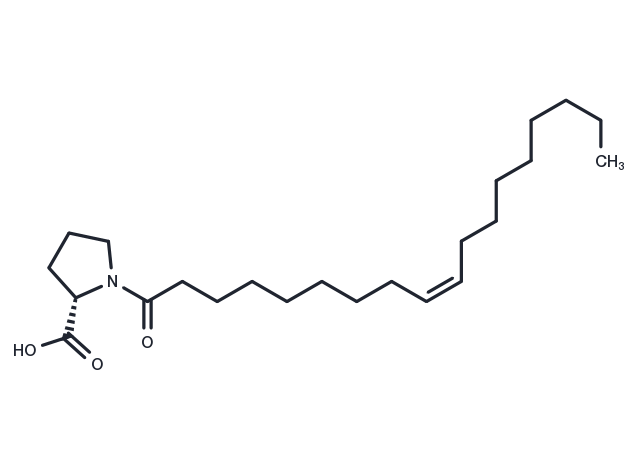keep away from moisture
Powder: -20°C for 3 years | In solvent: -80°C for 1 year

Oleoyl proline is an N-acyl amine that can be detected in bovine brain extracts and D. melanogaster larvae using mass spectrometry. In a preclinical model of pain, mice lacking fatty acid amide hydrolase (FAAH KO) had decreased N-oleoyl proline levels in the lumbar spinal cord after capsaicin administration (1 µg/10 µl).

| Pack Size | Availability | Price/USD | Quantity |
|---|---|---|---|
| 1 mg | 35 days | $ 93.00 | |
| 5 mg | 35 days | $ 394.00 | |
| 10 mg | 35 days | $ 693.00 | |
| 25 mg | 35 days | $ 1,540.00 |
| Description | Oleoyl proline is an N-acyl amine that can be detected in bovine brain extracts and D. melanogaster larvae using mass spectrometry. In a preclinical model of pain, mice lacking fatty acid amide hydrolase (FAAH KO) had decreased N-oleoyl proline levels in the lumbar spinal cord after capsaicin administration (1 µg/10 µl). |
| Synonyms | N-Oleoyl-l-proline |
| Molecular Weight | 379.58 |
| Formula | C23H41NO3 |
| CAS No. | 107432-37-1 |
keep away from moisture
Powder: -20°C for 3 years | In solvent: -80°C for 1 year
You can also refer to dose conversion for different animals. More
bottom
Please see Inhibitor Handling Instructions for more frequently ask questions. Topics include: how to prepare stock solutions, how to store products, and cautions on cell-based assays & animal experiments, etc.
Oleoyl proline 107432-37-1 N-Oleoyl-l-proline inhibitor inhibit
